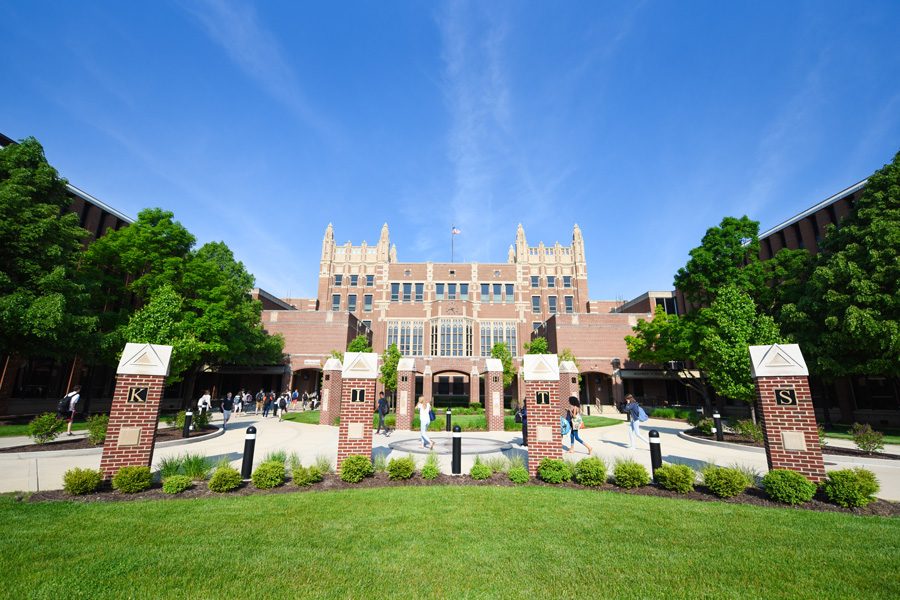Evanston officials seek solutions to digital accessibility discrepancy
(Daily file photo by Daniel Tian)
Evanston Township High School, 1600 Dodge Ave. The school began distributing 15 hotspots to students last spring in an effort to increase digital accessibility.
April 29, 2018
When the Evanston Public Library released a report on digital literacy in January 2016, one piece of information specifically sparked concern: The survey found that 14 percent of Evanston residents did not have access to Wi-Fi in their homes.
“I would credit the survey for creating a sense of urgency among city staff and other stakeholders and school districts,” said Luke Stowe, Evanston’s chief information officer. “If 14 percent is truly the number, then that’s about 14 percent too much, in our opinion.”
Lack of access to the internet and computers, commonly referred to as the city’s “digital divide,” has sparked concern and action from city staff and at EPL, Evanston/Skokie School District 65 and Evanston Township High School/District 202.
The city’s efforts to address the divide since the survey include mapping locations in Evanston that offer free Wi-Fi and attracting more local internet service providers to Evanston in an effort to increase competition and drive down prices. Stowe said he and his team have tried to increase awareness about the availability of subsidized internet packages that many carriers offer for families that meet certain income requirements.
He also said the library has begun a mobile hotspot lending program to decrease the divide. Almost 100 hotspots are currently in circulation.
Although Stowe believes the root causes of the divide are largely related to income differences in the city, he said the exact cause and more specific data on the divide remain unknown.
“The library survey focused more on skill sets and how internet and tech savvy someone is,” Stowe said. “We want to dig a little bit deeper on the actual nuts and bolts. If you do have internet, let’s hear all about that. … Or if you don’t have it, why not and how can we help close that gap?”
Evanston digital services specialist Hillary Beata (Medill ’08) said the city has drafted a survey to collect additional data on digital accessibility in Evanston and plans to release it later this year.
Still, Stowe and Beata said current efforts to address the digital divide operate within a tight budget, but do not want to invest much more in digital accessibility efforts.
EPL technical services director Tim Longo said the library is “where we want to be in terms of the money we’re spending” on digital accessibility and literacy efforts. He also noted that limited city funding has restricted the number of mobile hotspots in circulation.
“Our demand exceeds supply,” Longo said. “We’ve never even come close to reaching a level where a patron could just walk in and not have to wait for (a hotspot).”
Beginning in spring 2017, 15 of the hotspots were made available to ETHS students and 10 to Lincoln Elementary School students, Longo said.
But ETHS director of instructional technology David Chan said that like EPL, the school does not have enough hotspots to accommodate each student who requests one.
“We found that when we heavily promoted (the hotspots) we got a steady influx,” Chan said. “All of a sudden, all these people were coming in, but then at the same time we had a limited supply so we haven’t put full … pressure on marketing and promoting it because we don’t want to have to turn 100 people away.”
And students can still lack access to internet after leaving the classroom.
Chan said even after the school began providing laptops to incoming freshmen in the 2014-15 academic year, students without access to the internet at home could not collaborate remotely with other students or submit work — even though they could still work on assignments offline.
“If you don’t have that ability (to access the internet) or you have to leave your house to go to the library or go somewhere before or after school to find somewhere that has Wi-Fi, it can be a major inconvenience,” Longo said. “It just gets back to this idea: Living in the year 2018 and not having access to the internet, you’re behind. You really can’t compete or get ahead or better yourself without access to the internet.”
Stowe said the effort to close the city’s digital divide may require more funding over time, but he believes partnerships with the school districts, EPL, Northwestern and the private sector can aid in the effort to close the gap.
He and Beata also said they expect the upcoming digital accessibility survey to make the goal more achievable.
“In an ideal world, everyone would have some sort of device,” Stowe said. “They would have the digital skills that they need and they would have either free or inexpensive internet. Obviously that’s ideal conditions, but I do think that we can make substantial progress to get closer to that vision. But it’s going to take some time too.”
Email: [email protected]
Twitter: @ByChrisVazquez


